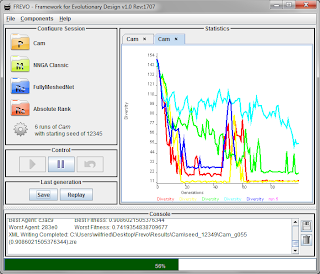IWSOS 2013
7th International Workshop on Self-organizing Systems
Palma de Mallorca, Spain
May 9-10, 2013
Technical co-sponsors: IFIP TC6 WG6.2, EC FP7 NoE EINS
Poster Abstract Submission Deadline: March 15, 2013
We are looking for submissions of research posters, from both academia and industry, describing research, exciting new research projects, and encouraging preliminary results on self-organizing systems.
** Poster Abstract Submission
The submission should be an extended abstract of two pages in two-column format. All submitted abstracts will undergo a peer review process. Accepted posters must be presented at the conference and will be published electronically in a book (ISBN-indexed) named "Emerging Ideas on Self-Organizing Systems".
Poster abstracts should use the following format:
http://ifisc.uib-csic.es/iwsos2013/media/poster_latex_template.zip
Poster abstracts can be submitted via:
https://www.edas.info/newPaper.php?c=13239&track=31695
** Important Dates
Submission deadline: March 31, 2013
extended!
Notification: March 31, 2013
Camera-ready: April 15, 2013
** Scope
The main themes of IWSOS 2013 are from the fields of techno-social systems and networks-of-networks with their unique and complex blend of cognitive, social, and technological aspects. We will analyse how these systems self-organize, acquire their structure, and evolve. Thus, we aim to advance our understanding of such key infrastructures in our societies and, more generally, of these sorts of self-organizational processes in nature. We are further interested in learning how to engineer such self-organizing networked systems to have desirable properties including dependability, predictability, and resilience in the face of the inevitable challenges that they face. Building on the success of its predecessors, this multi-disciplinary workshop aims at bringing together leading international researchers from complex systems, distributed systems, and communication networks to create a visionary forum for discussing the future of self-organization in networked systems. We invite the submission of manuscripts that present original research results on the themes of self-organization in techno-social systems and networks-of-networks.
** Key Topics
The workshop scope includes, but is not limited to, the following topical areas of self-organizing systems:
- Design and analysis of self-organizing and self-managing systems
- Inspiring models of self-organization in nature and society
- Structure, characteristics, and dynamics of self-organizing networks
- Self-organization in techno-social systems
- Self-organized social computation
- Self-organized communication systems
- Citizen Science
- Techniques and tools for modeling self-organizing systems
- Tools to quantify self-organization
- Control and control parameters of self-organizing systems
- Phase transitions in self-organizing systems
- Robustness and adaptation in self-organizing systems
- Self-organization in complex networks such as peer-to-peer, sensor,
ad-hoc, vehicular, and social networks
- Self-organization in socio-economic systems
- User and operator-related aspects of man-made self-organizing systems
- Self-organizing multi-service networks and multi-network services
- Methods for configuration and management of large, complex networks
- Self-protection, self-configuration, diagnosis, and healing
- Self-organizing group and pattern formation
- Self-organizing mechanisms for task allocation, coordination and
resource allocation
- Self-organizing information dissemination and content search
- Security and safety in self-organizing networked systems
- Risks and limits of self-organization
- The human in the loop of self-organizing networks
- Social, cognitive, and semantic aspects of self-organization
- Evolutionary principles of the (future, emerging) Internet
- Decentralized power management in the smart grid
 An Advent calendar is a special calendar used to count or celebrate
the days in anticipation of Christmas. Advent calendars typically begin
on December 1 and provide a window to open until December 24. Usually
they have windows, which you can open each day containing some chocolate
or other stuff. But what is better to kill some time until Christmas,
Hanukkah, Yule, Kwanzaa, Diwali, Boxing Day, etc. than an Advent
calendar giving you a programming problem every day?
An Advent calendar is a special calendar used to count or celebrate
the days in anticipation of Christmas. Advent calendars typically begin
on December 1 and provide a window to open until December 24. Usually
they have windows, which you can open each day containing some chocolate
or other stuff. But what is better to kill some time until Christmas,
Hanukkah, Yule, Kwanzaa, Diwali, Boxing Day, etc. than an Advent
calendar giving you a programming problem every day?



















